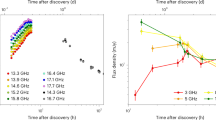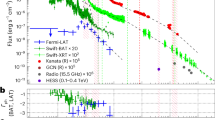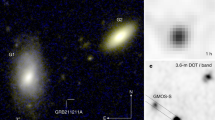Abstract
In addition to its remarkable supernova signature1,2, the γ-ray burst of 29 March 2003 (GRB030329) had two interesting peculiarities: an unusually low-energy output in γ-rays and a large bump in its afterglow light curve after 1–2 days (followed by several less significant rebrightening episodes). We suggest that refreshed shocks — slow shells ejected from the source that catch up with the afterglow shock a relatively long time after the initial burst — produced the observed fluctuations in the early afterglow light curve and explain the low-energy output at early times.
This is a preview of subscription content, access via your institution
Access options
Subscribe to this journal
Receive 51 print issues and online access
$199.00 per year
only $3.90 per issue
Buy this article
- Purchase on SpringerLink
- Instant access to full article PDF
Prices may be subject to local taxes which are calculated during checkout

Similar content being viewed by others
References
Stanek, K. Z. et al. Astrophys. J. 591, L17–L20 (2003).
Hjorth, J. et al. Nature 423, 847–850 (2003).
Price, P. A. et al. Nature 423, 844–847 (2003).
Rees, M. J. & Mészáros, P. Astrophys. J. 496, L1–L4 (1998).
Kumar, P. & Piran, T. Astrophys. J. 532, 286–293 (2000).
Sari, R. & Mészáros, P. Astrophys. J. 535, L33–L37 (2000).
Granot, J., Miller, M., Piran, T., Suen, W. M. & Hughes, P. A. in Gamma-Ray Bursts in the Afterglow Era (eds Costa, E., Frontera, F. & Hjorth, J.) 312–314 (Springer, Berlin, 2001).
Author information
Authors and Affiliations
Corresponding author
Ethics declarations
Competing interests
The authors declare no competing financial interests.
Rights and permissions
About this article
Cite this article
Granot, J., Nakar, E. & Piran, T. refreshed shocks from a γ-ray burst. Nature 426, 138–139 (2003). https://doi.org/10.1038/426138a
Issue date:
DOI: https://doi.org/10.1038/426138a



